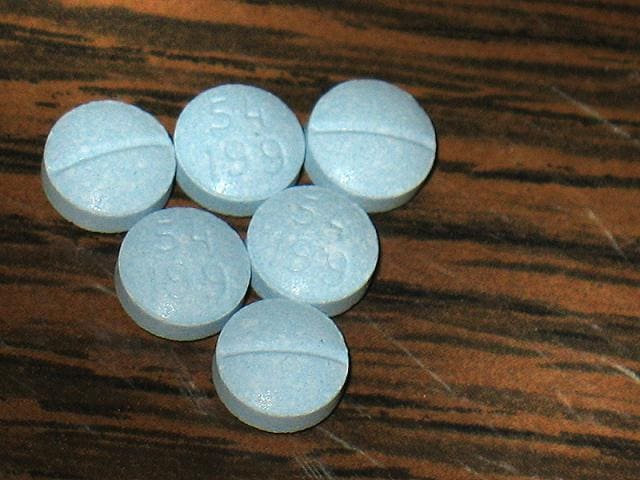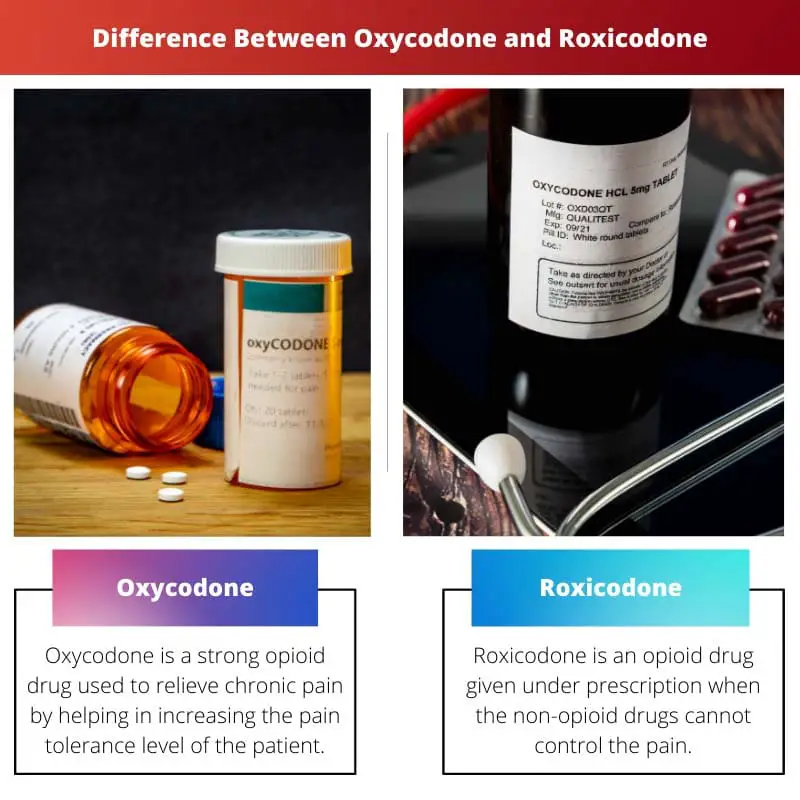Oxycodone and Roxicodone are both prescription drugs used to reduce pain, which normal reliever drugs cannot. Oxycodone and Roxicodone both belong to the same opioid drug category. The physicians prescribe these opioid drugs to get help with their patients’ pain.
Key Takeaways
- Roxicodone is a brand name for oxycodone, so they share the same active ingredient.
- Roxicodone comes in a fast-acting, immediate-release form, while oxycodone is available in both immediate and extended-release versions.
- Both drugs are powerful opioid painkillers that require a prescription and carry a risk of addiction.
Oxycodone vs Roxicodone
Oxycodone is a generic name for opioid pain medication that is available in various forms, including tablets, capsules, and liquids. Roxicodone is a brand name for a specific formulation of oxycodone, which is an immediate-release tablet that is used for the management of acute pain.

Oxycodone is a strong opioid drug used to relieve chronic pain by helping in increasing the pain tolerance level of the patient. It is used when prescribed by a physician to relieve severe pain when other medications are insufficient. It is the common name or the generic name of the medication.
Roxicodone is an opioid drug given under prescription when the non-opioid drugs cannot control the pain. It is the brand name of the drug Oxycodone. It has the same formulation as Oxycodone. The physicians prescribe them when someone is having moderate to severe pain.
Comparison Table
| Parameters of Comparison | Oxycodone | Roxicodone |
|---|---|---|
| How does the drug work, when it is consumed? | It increases a person’s tolerance to pain. | It helps with pain relief immediately. |
| how does the drug relieve the pain? | It is used to relieve strong cough and narcotic pain. | Roxicodone is used to treat moderate to severe pain. |
| Common side effects of the drug. | The common side effects of Oxycodone include nausea, dizziness, headache, constipation, and sweating. | It can cause slow heart rate and breathing problems. |
What is Oxycodone?
Oxycodone is an analgesic opioid drug which means that it helps to ease pain like codeine and morphine. It does not eliminate the patient’s pain; it increases one person’s tolerance level. Oxycodone is a very addictive drug. It is taken in by a patient through the mouth.
Oxycodone is the common or generic name of the medication. Doctors started using this in 1917 and have used it since then to relieve many patients.
Oxycodone is sold under the brand name of Roxicodone and OxyContin.
It is used when one is having severe pain, and the other medication cannot help them. This drug can also relieve those who have pain while coughing.
Oxycodone is the active ingredient in many pain relievers. After the introduction of oxycodone, it has been used in cancer-related pain and the problems of non-chronic-cancer problems.
The side effects of Oxycodone include dizziness, drowsiness, nausea, vomiting, and constipation.
There can be adverse experiences that may occur to someone who has consumed Oxycodone orally. These adverse experiences include abdominal pain, allergic reaction, body pain, chills, migraine, hypotension, vomiting, nausea, haemorrhage, and heart failure. These are not the only side effects that may happen.

What is Roxicodone?
Roxicodone is the brand name of Oxycodone drug. When the Roxicodone tablet is consumed orally, it immediately releases the Oxycodone drug, and it relieves the person instantly.
Roxicodone drugs are also known as oxycodone hydrochloride tablets USP. The tablet is white in colour and odourless. They are moderately priced drugs. They can dissolve in water and can dissolve slightly in alcohol too. They are opioid analgesics, which can be used to treat people with moderate and severe pain. They are strictly indicated for oral use only.
Roxicodone cannot be used for people below 18 years or people with liver and kidney disease, and it can cause harmful effects on one’s health. They should not be consumed by people who have hypersensitivity to this tablet.
The physicians prescribe 5 mg, 15 mg, or 30 mg of Roxicodone to their patients, when consumed, it immediately releases the oral formulation of oxycodone hydrochloride and helps with moderate or severe pain.
The side effects of Roxicodone are headache, dizziness, tiredness, constipation, stomach pain, nausea, and vomiting. It may also cause some serious side effects like slow heart rate, shallow breathing, and weak pulse. These are not the only side effects that may happen.
The active signs of overdosage on Roxicodone can cause cold skin, constricted pupils, hypotension, respiratory depression, and even death.

Main Differences Between Oxycodone and Roxicodone
- The difference between Oxycodone and Roxicodone is that Oxycodone is the generic name of the drug, and Roxicodone is the drug’s brand name.
- Oxycodone is used to relieve strong coughs and narcotic pain, while Roxicodone is used to treat moderate to severe pain.
- Oxycodone does not work immediately, whereas Roxicodone works as soon as someone consumes the drug.
- Oxycodone increases the pain tolerance level of someone who consumes it, whereas Roxicodone helps in immediate results.
- Though Oxycodone and Roxicodone have the same formulation, they differ from person to person in the quantities they consume every day.


The detailed description of both drugs, their formulations, and the conditions for their prescription offer valuable insights. This information would be beneficial for anyone who needs to make informed decisions regarding pain management.
It’s important for physicians and patients to be well-informed about the characteristics and differences of these opioid drugs to ensure their safe and appropriate use. Thanks for providing such detailed information.
Both Oxycodone and Roxicodone are powerful opioid painkillers that have the same active ingredient, but some differences exist in their form and how they manage pain.
The comparison table and detailed information about each drug’s side effects and actions and the need for prescriptions provide a thorough understanding of the topic.
This article offers a comprehensive comparison between Oxycodone and Roxicodone, shedding light on their respective forms, mechanisms of action, and potential side effects. It’s informative and useful for healthcare professionals and patients alike.
The article effectively discusses the similarities and differences in the usage and effects of Oxycodone and Roxicodone, providing an informed perspective for both medical professionals and patients.
The discussion on side effects and prescription details further establishes the significance of informed decision-making. However, a more detailed explanation could strengthen the understanding for potential users.
Understanding the differences between Oxycodone and Roxicodone could be crucial in the effective management of pain. This is especially important given the risks and side effects associated with these powerful opioid drugs.